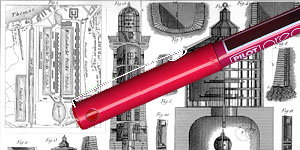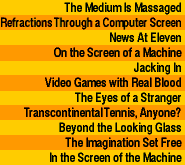


The Medium is Massaged
Few of us have yet had the luxury of seeing the latest fantastic graphics on the screen of an advanced computer. The hardware is still expensive and the software is still crude. Even so, most of today's newspapers, magazines, and books have already passed through a computer at some point. Thus the most immediate effect computers have had on the graphic world has been through the printed page.When we take a pen to paper, whatever we write or draw is the original, and a reproduction is just that: a copy. But when working on the computer there isn't any original. Every copy, whether it's the first or the millionth, is just as clear, accurate, and valid as any other.
In addition, when created on a computer, the appearance of a page of text, a drawing, a painting, or a movie is malleable. Revision in the traditional plastic arts---painting, sculpting, film---used to be hard, but no longer. On the computer, the graphic arts come to resemble a jazz performance, where the original melody is merely a set of loose instructions and the interpretation can be unique every time.
Once we have something in a computer, we gain unprecedented control over it. For example, we can change, distort, or rearrange a photograph without damaging the original. With the right software, we can give Aunt Edna a haircut and see how she looks with it before making a print. This control has interesting consequences. Perhaps you just received a fashion catalog showing models wearing various articles of clothing. Everything looks real. However, some of the models may never have worn some of those clothes. The models are real, the clothes are real, but the application of the clothes to the models' bodies may have happened only inside a computer. In a few cases, the clothes may not even be real. Eventually, perhaps, the models won't be either.
Already today, after a photo shoot, fashion photographers often retire to their computers and rearrange their pictures. Faces can become wrinkle free, hair more lustrous, irises more brilliant, eye whites whiter. Eyes may move, ears may shrink, mouths may widen, and necks and legs may lengthen. Models might find that they've miraculously lost weight in various places---and gained it in others. The changes are usually subtle, but the overall effect can be to create almost a new person. Electronic surgery is far cheaper, quicker, and less painful than the real thing.
Touching up photographs is normal. But this level of manipulation is new; it's the creation of entirely new pictures. Further, to do it you don't need several thousand dollars' worth of photographic equipment or decades of photographic experience. All you need is a computer with the right software---which is getting cheaper by the minute.
Once upon a time, photojournalism was seen as the realm of objective observers, supposedly documenting the world as it was. "The camera never lies," it was said. Taking that as fact, courts still accept photographs and videotapes as evidence---although they may not for too much longer. Soon, millions of us will be able to alter any picture, seamlessly. And that has all kinds of consequences.